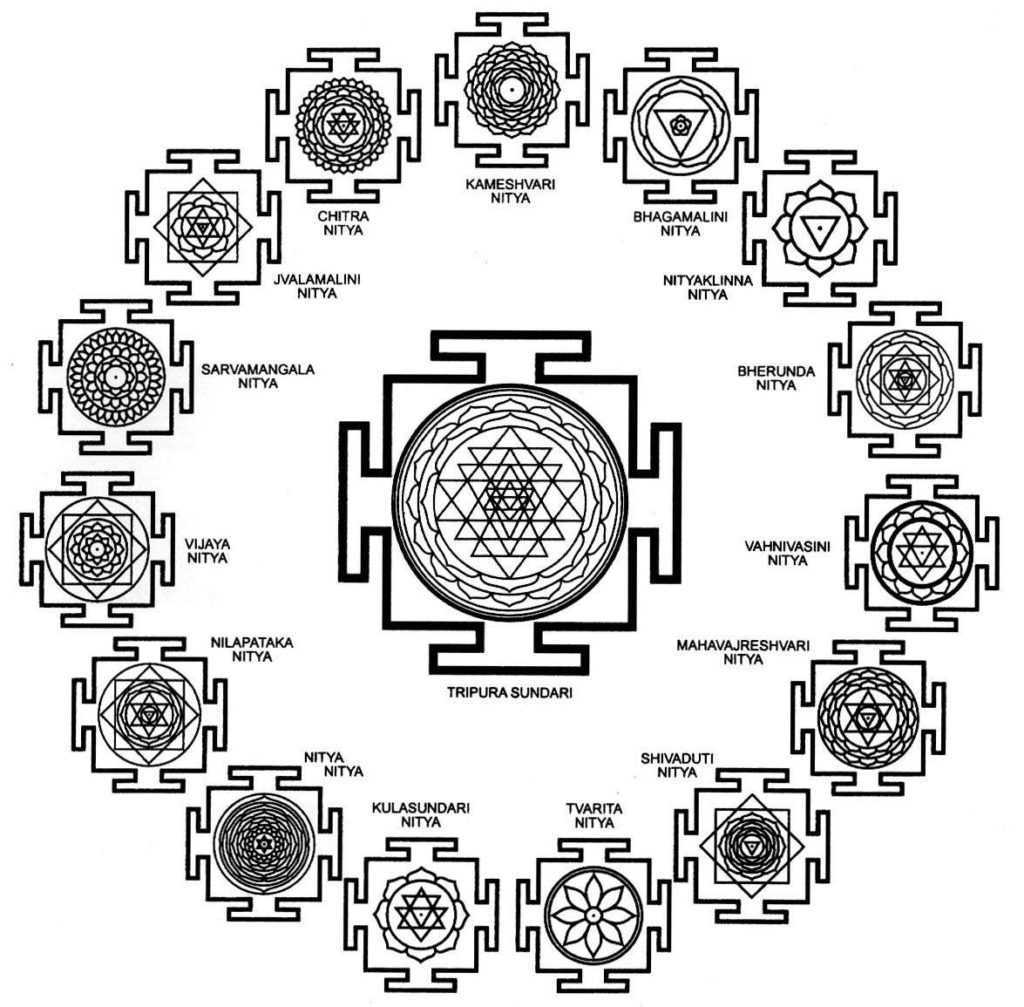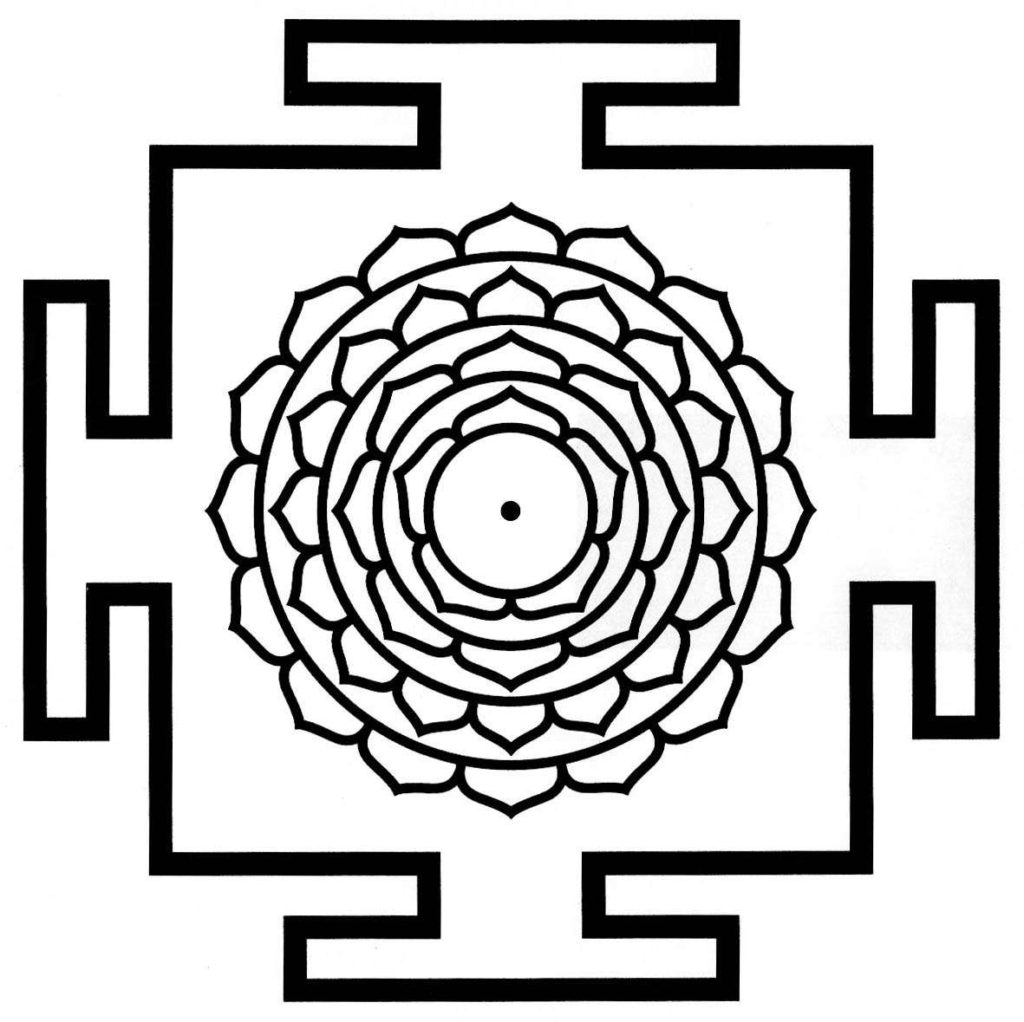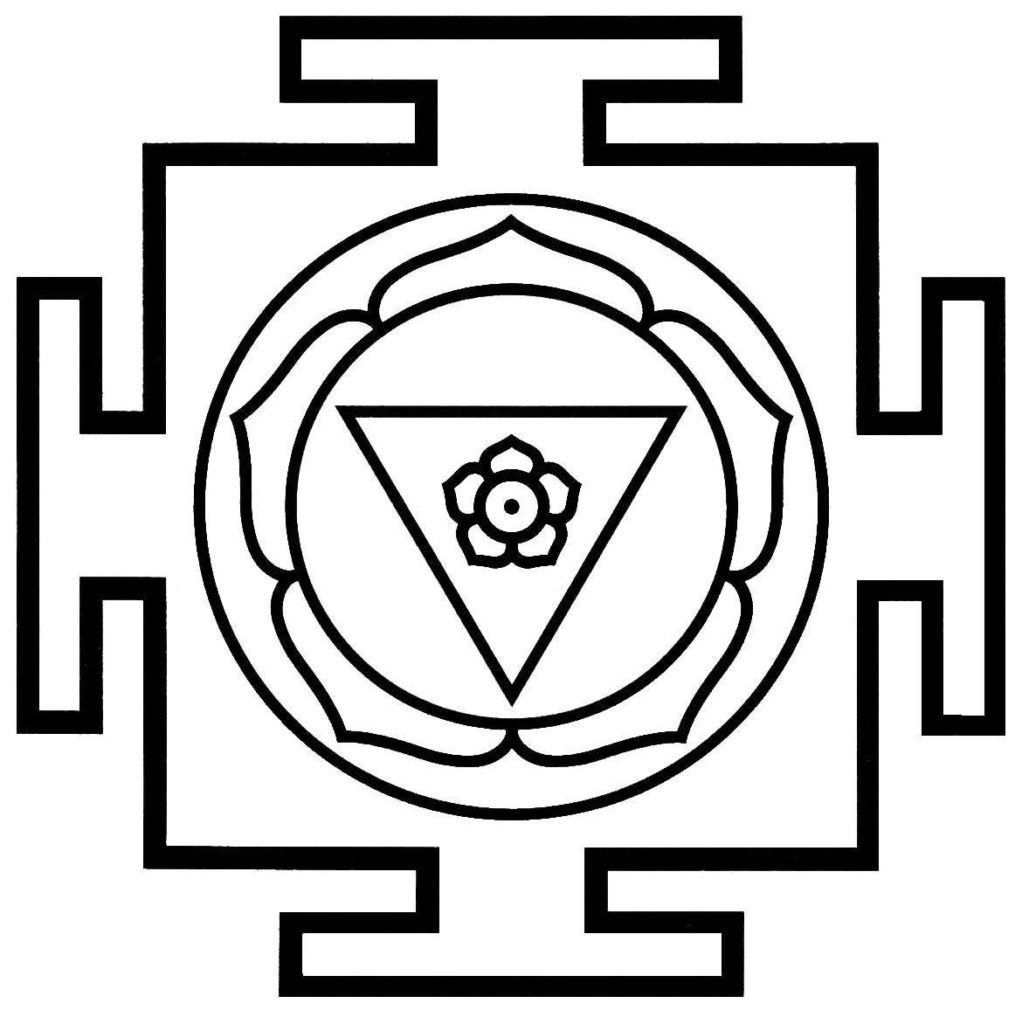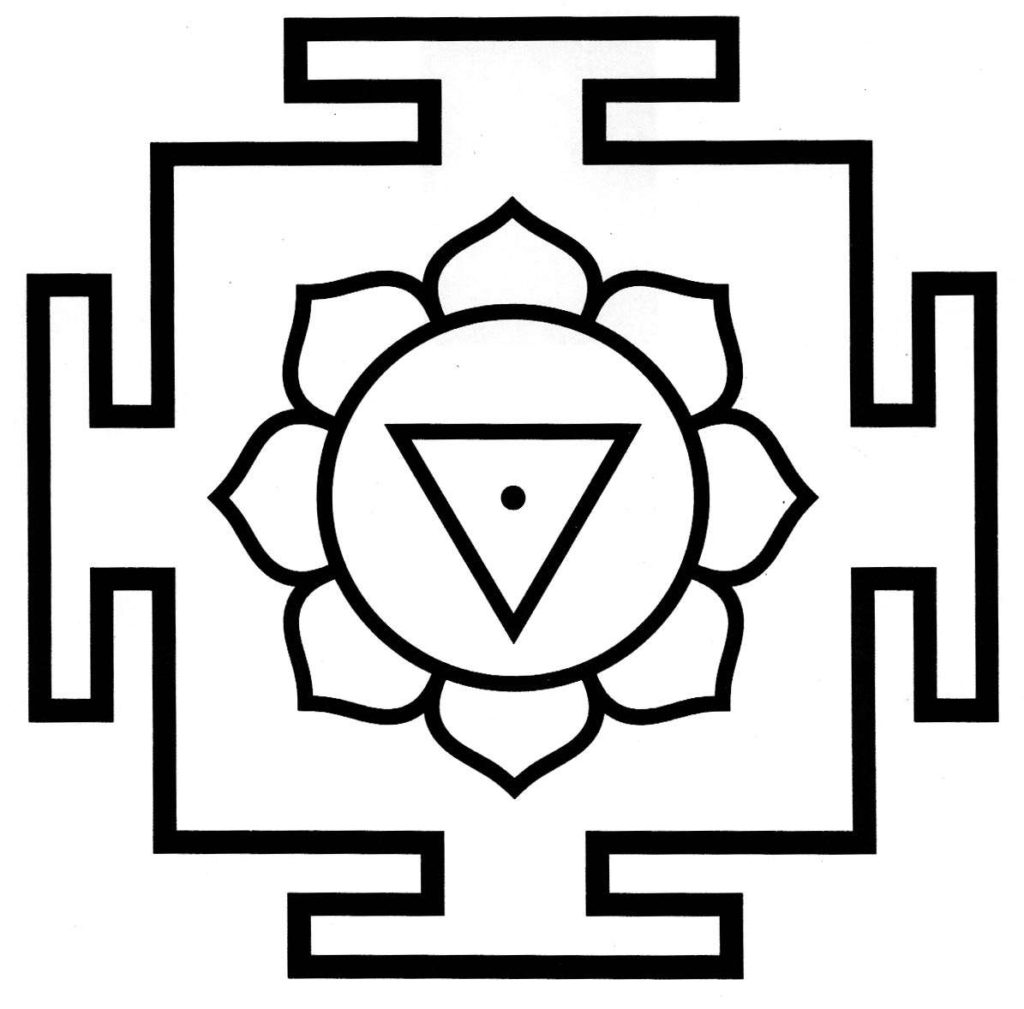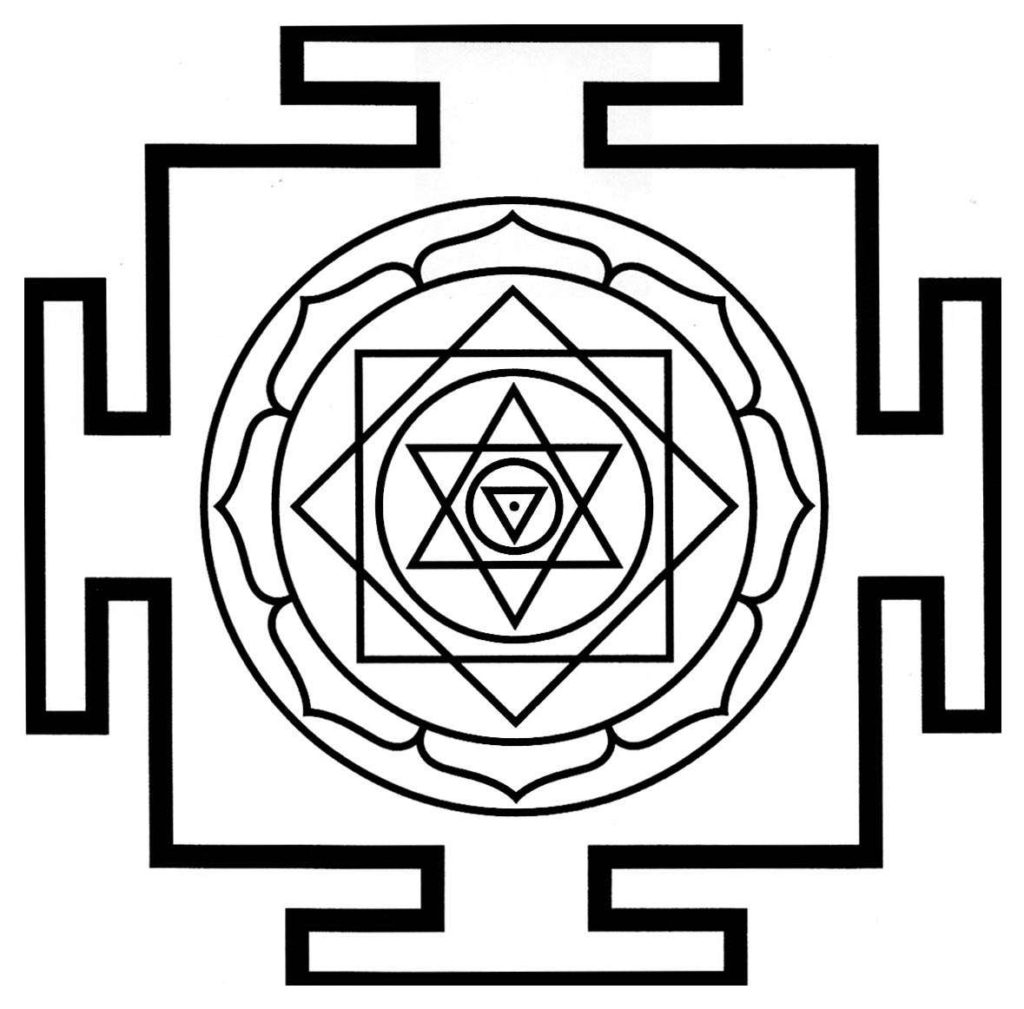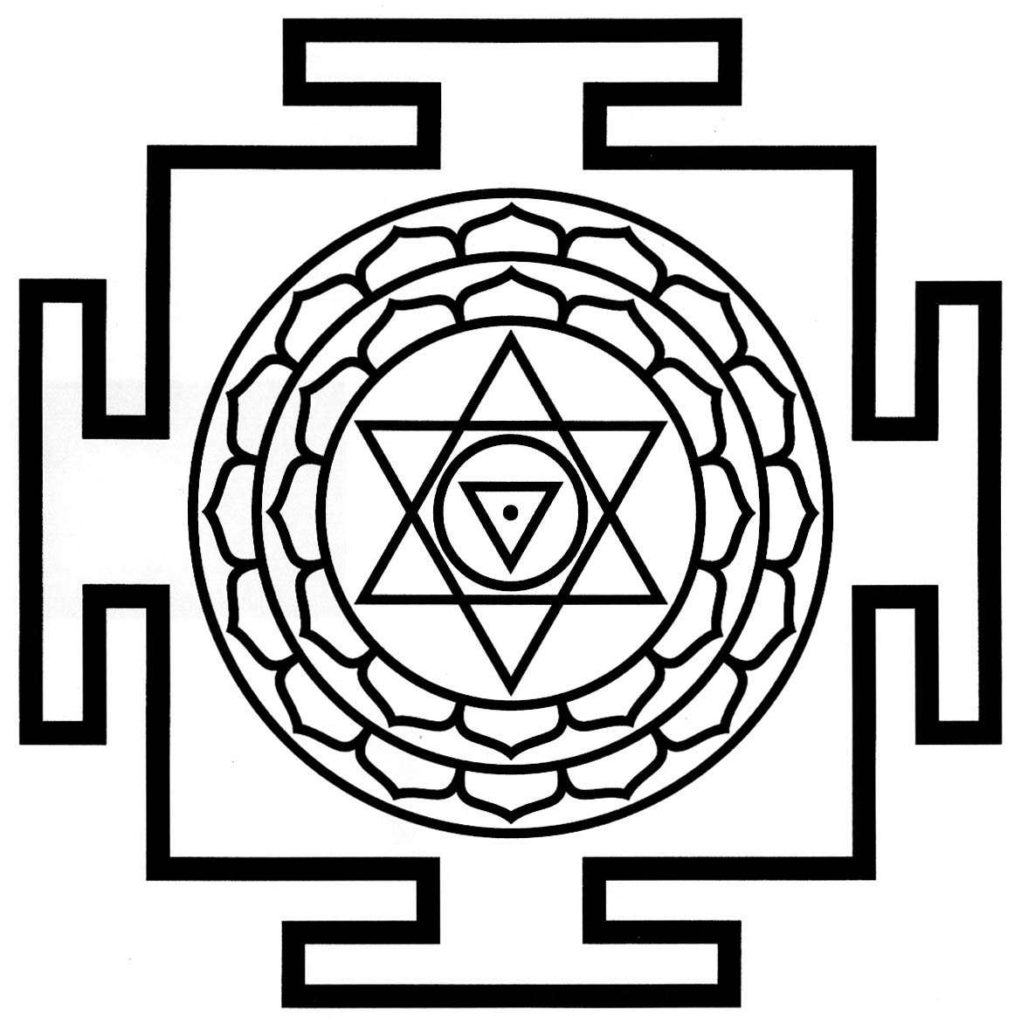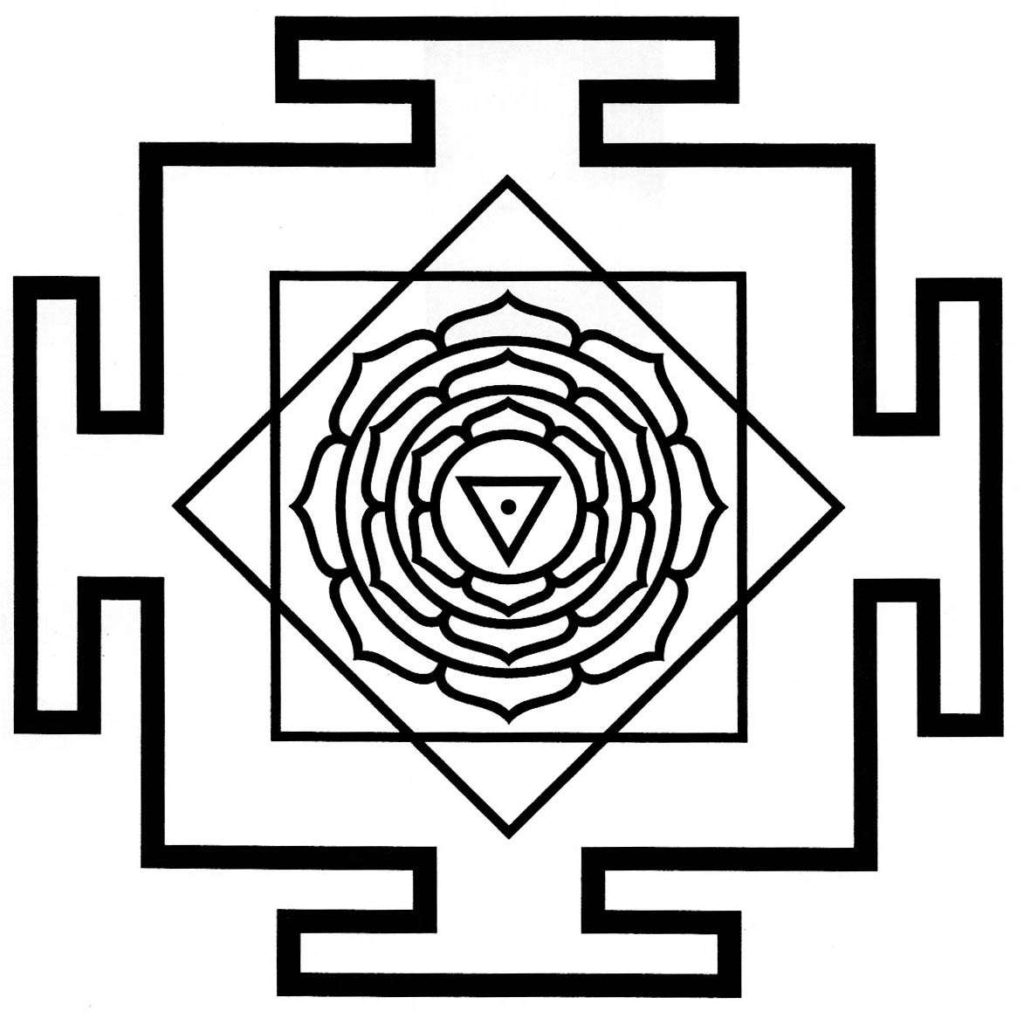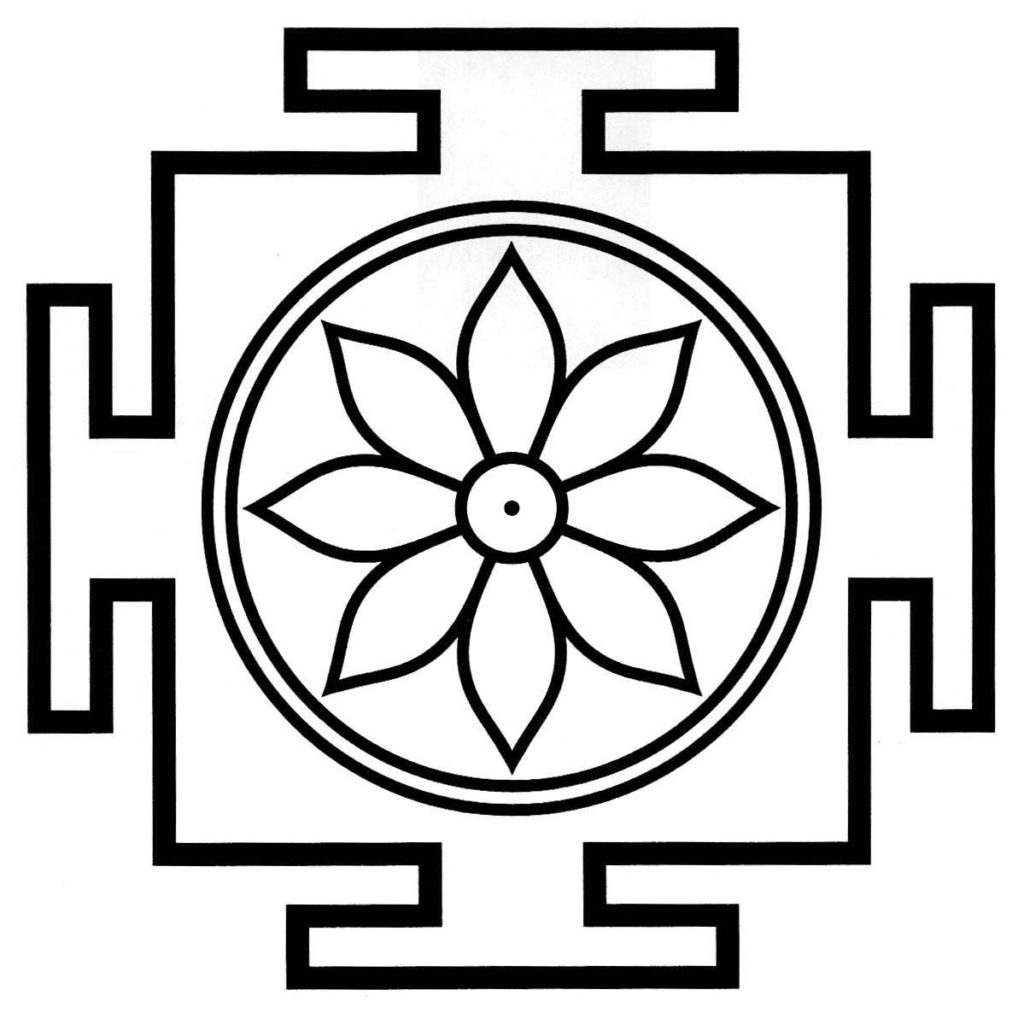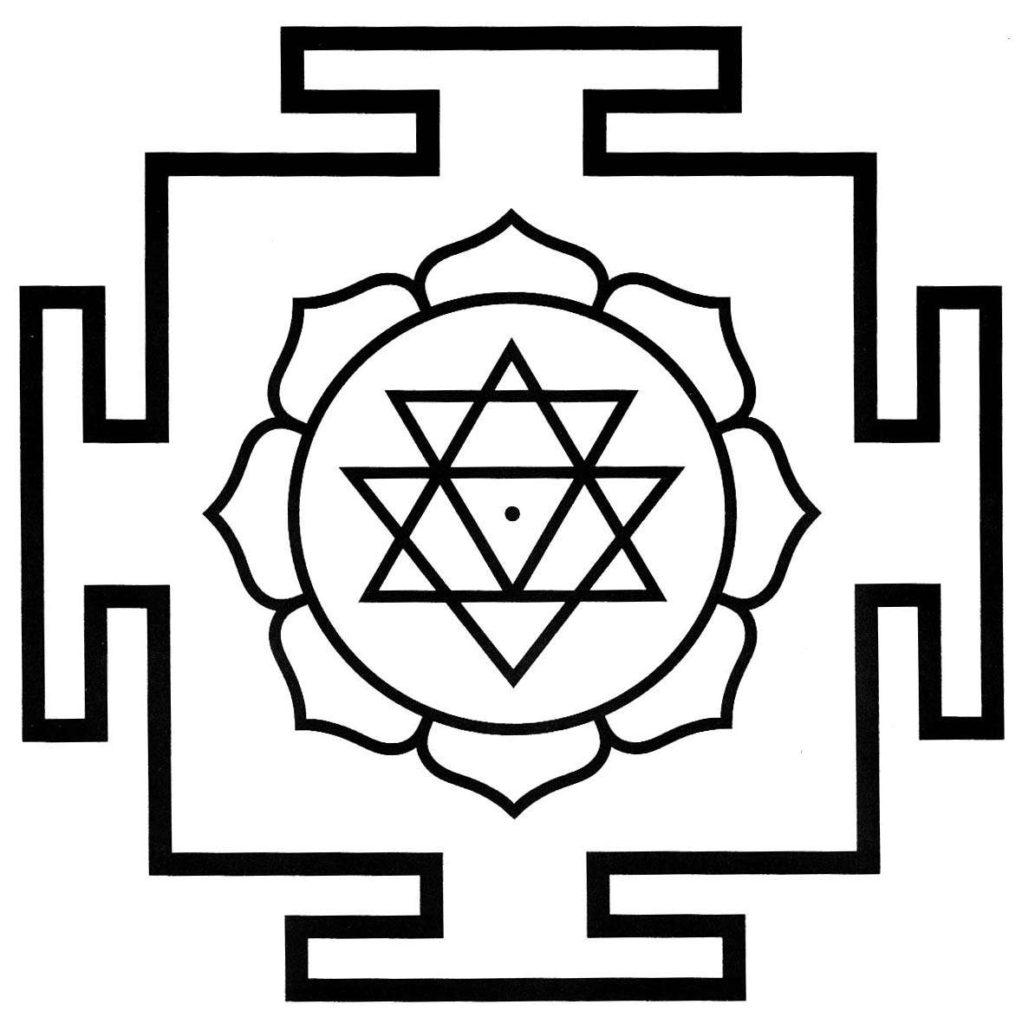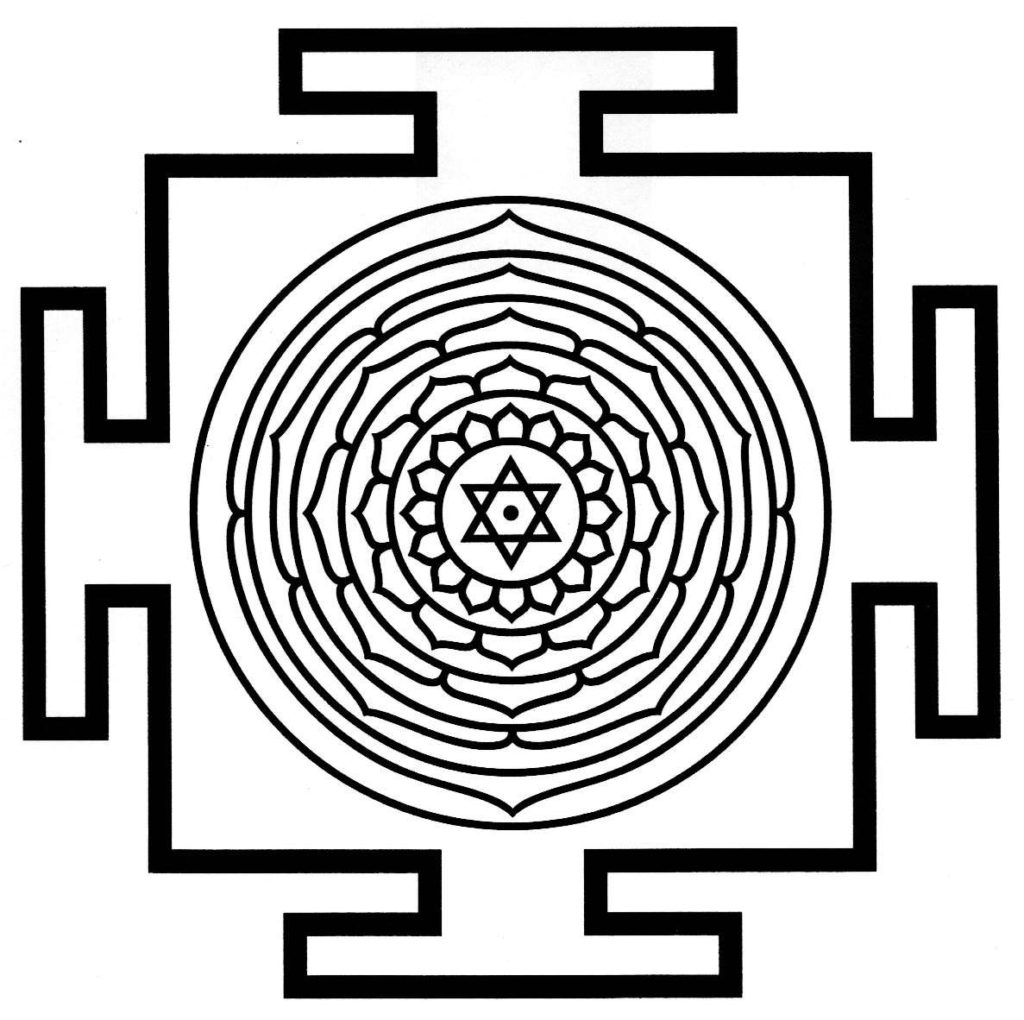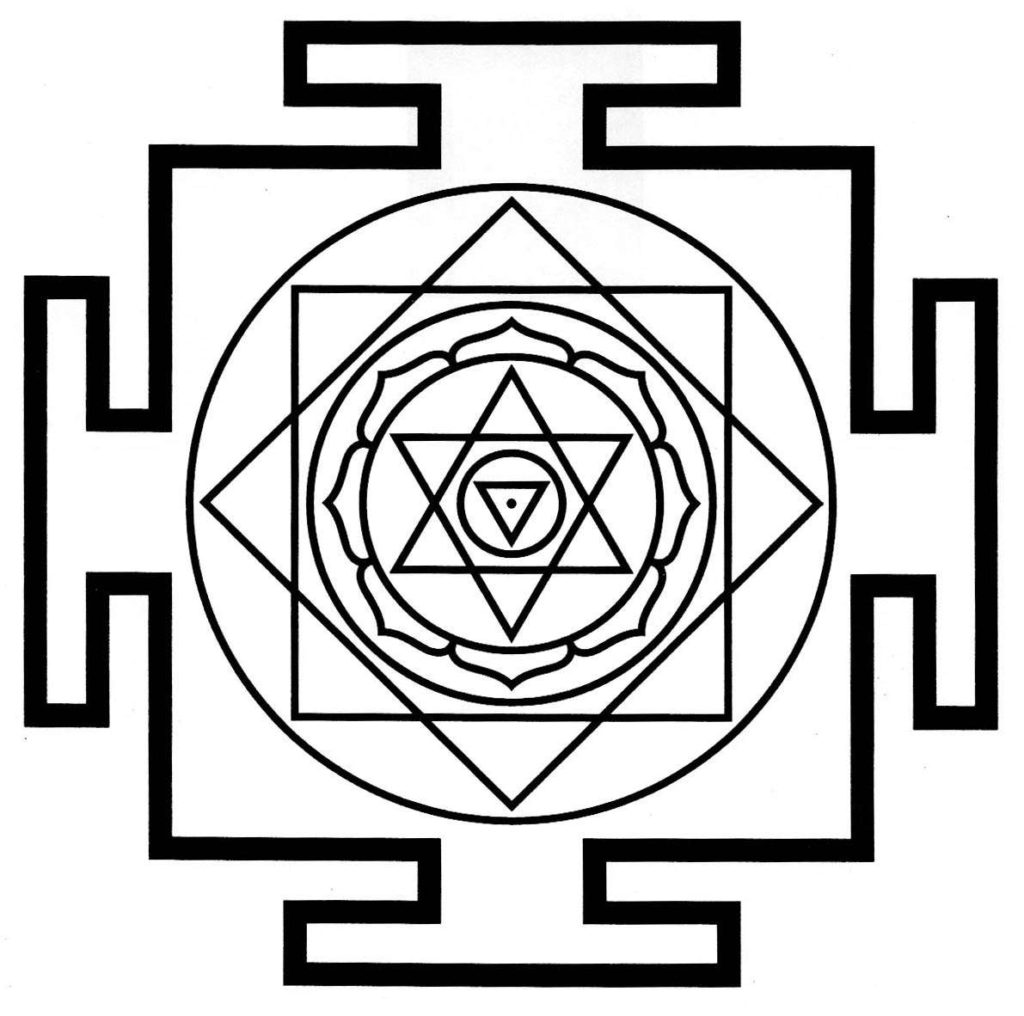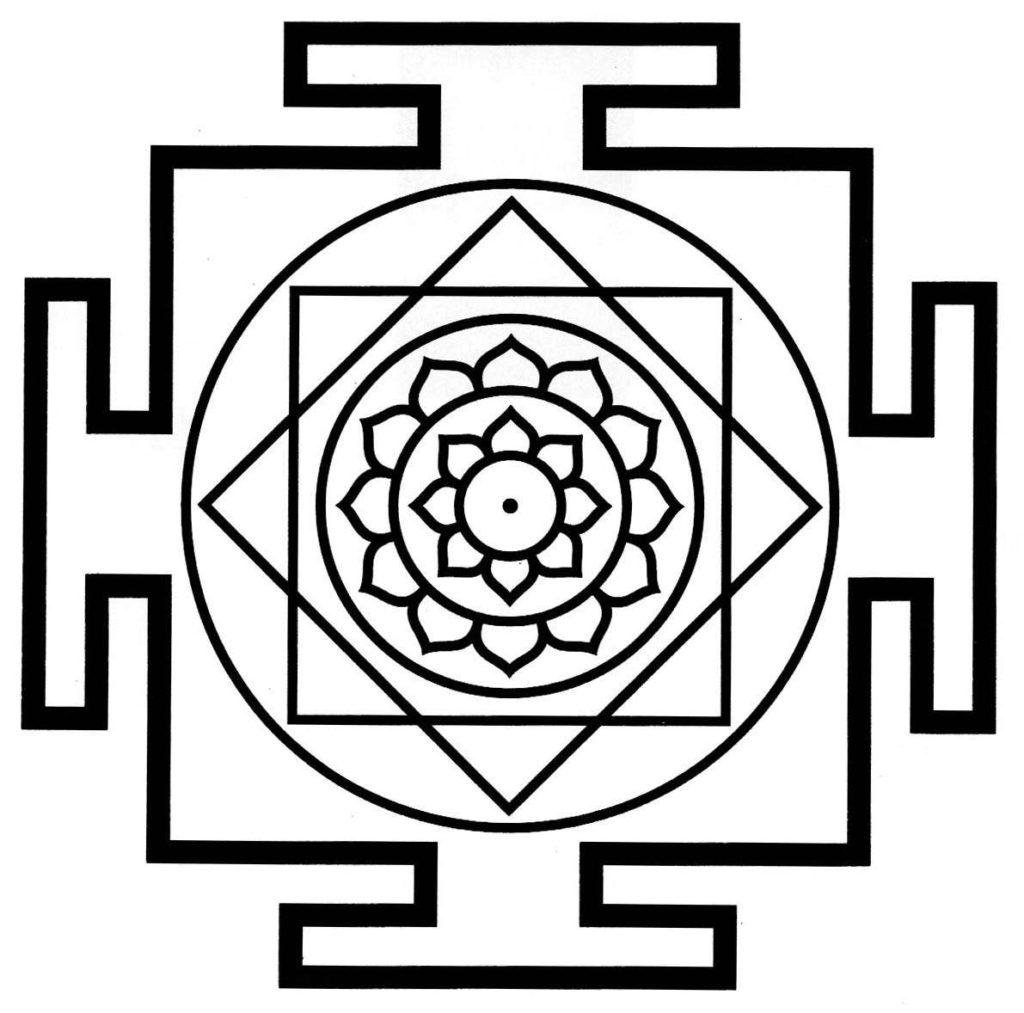The Nityas or the Eternities (or manifestations) of Tripura Sundari or Lalita, represent the fifteen lunar days (called tithis in Sanskrit) of the growing Moon.
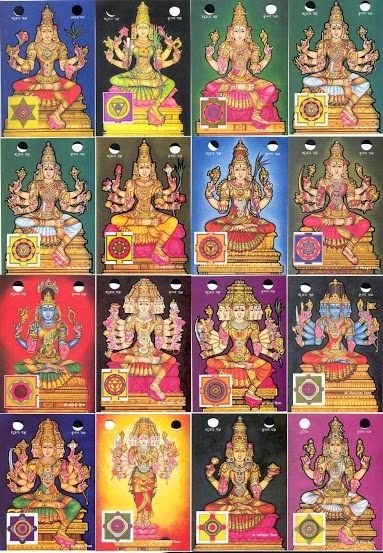
Each one has its own yantra, mantra, tantra, pranayama and/or ritual applications. The full circle of Nityas also represents the 21,600 breaths a human being takes during a full day and night. As such, the Nityas in the crescent moon represent the Kalachakra or Wheel of Time.

1.- Sources and origin
The information exposed in this post about Nityas in the crescent moon is a compendium of several tantras: the Tantraraja (which facilitates the magical rites, Mantras and Yantras associated with the Nityas), the Dakshinamurti Samhita (with different versions of Mantras and Yantras), the Jnanarnava Tantra and the Kalpasutra.
The 15 Nityas in the crescent moon are modifications of Lalita as a red goddess, with her three gunas and her five elements: éter, air, fire, water y earth. The moon appears differently depending on the phase, so does Lalita. Each Nitya has its own vidya or mantra, yantra and group of energies (Shaktis).
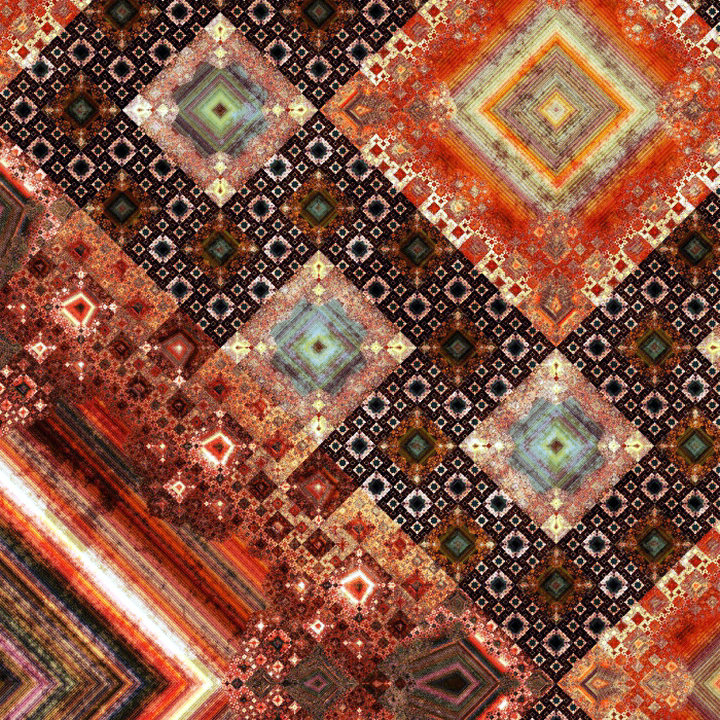
This system (external to its body and its Atman) in its manifestation is based on Time (kala), Space (deha) and a combination of the two. The known as fifteen Kalas of the Moon, represent the 15 lunar tithis, must be considered indetical to the fifteen Nityas (from Kameshvari to Chitra). The sixteenth Kala, called Sadakhya, has to be seen as one with Lalita or Sri Chakra. The tithichakra, or the wheel of time, is constantly turning, and the Sri Chakra is within, not without.
Gopinath Kaviraj, a scholar of tantra in the first half of the 20th century, describes the Kalachakra and the Nityas (Sarasvati Bhavana Granthamala, 1963)
Hence Lalita or Tripurasundari is the 16th or full moon. Each one of the Nityas in the crescent moon has a certain number of arms, being 108 arms the sum of their totality. Like any unit of time, in the microcosm and in parallel there is another valid unit, since each of the fifteen Nityas add up to 1,440 breaths. This identity between space and time is Tripurasundari.

2.- The manifested representation
The Nityas on the crescent moon are represented by the vowels of the Sanskrit alphabet, and are identical to both time and space. For example, if the number of tattvas or consonants (36) is multiplied by 16 Nityas, the number of letters is 576. Multiples of this number give the number of years in the various Yugas. So the circle of matrikas and nityas is identical with the zodiac and the mantra.
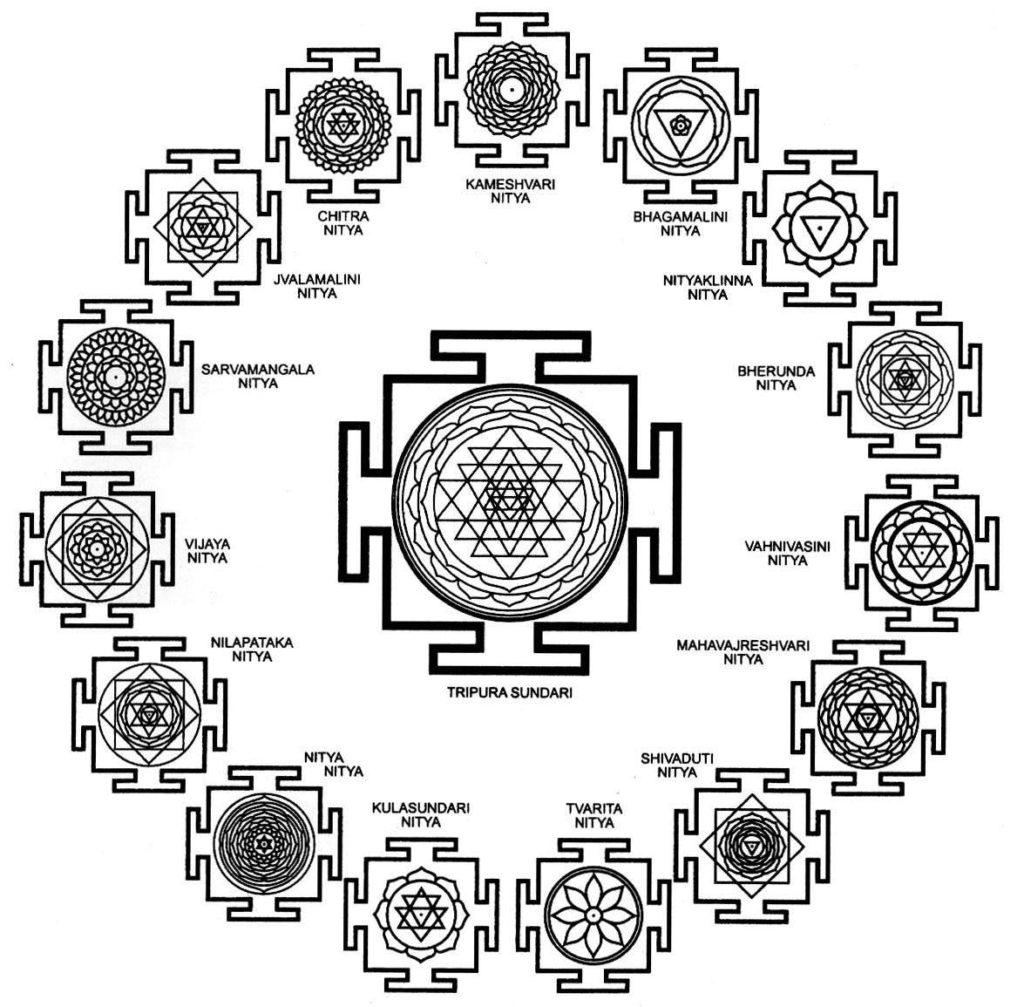
Shiva explains to us that, the Meru, is in the center of the world. Outside, there are the seven oceans, and beyond that, there is the Kalachakra or wheel of time, which moves thanks to the power of Icchi Shakti. The circle is divided by 12 spokes, and the 9 planets or grahas are within it. The tantra says Lalita is in the Meru, while the 14 Nityas from Kameshvari to Jvalamalini reside in the seven islands and seven oceans. Chitra, who is the fifteenth Nitya, occupies the supreme Space or Paramavyoma.
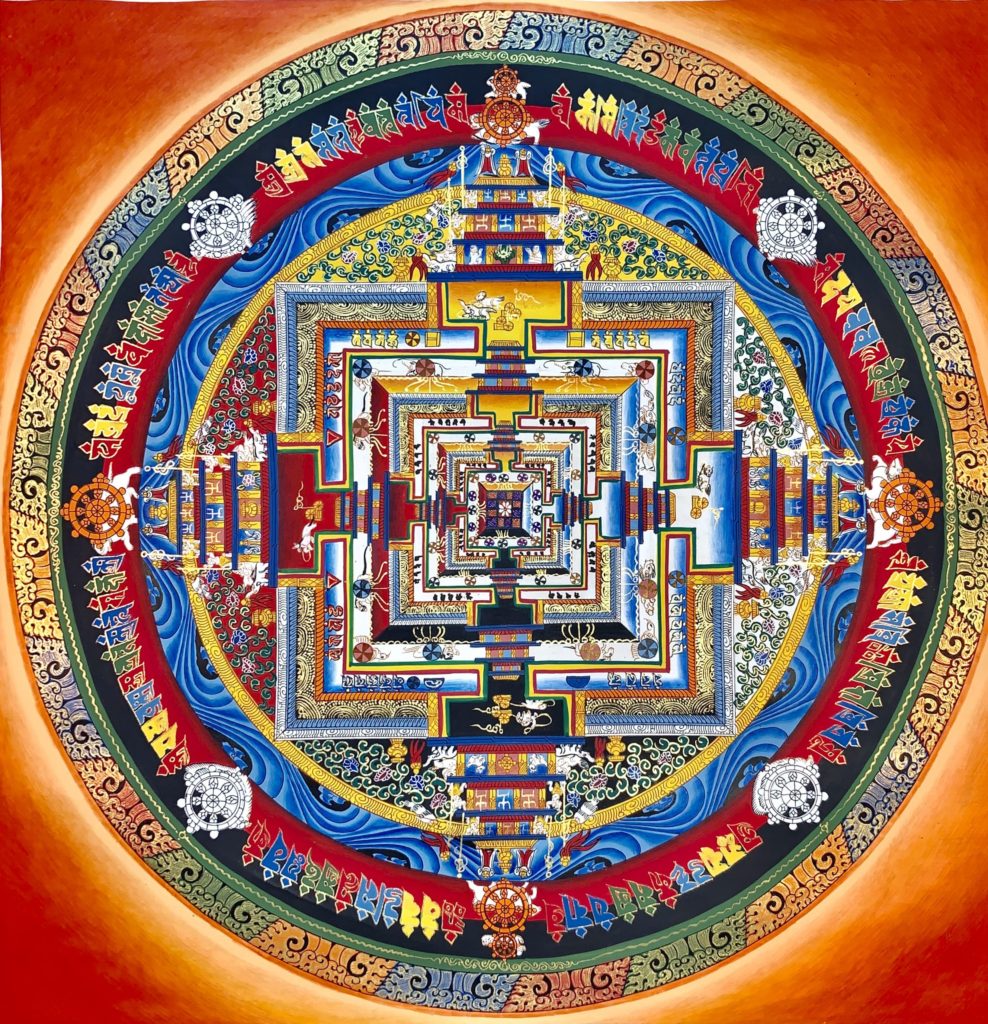
3.- Worship ways
In the Dakshinamurti Samhita, the Nityas in the crescent moon are identified with kalas or parts of the different stages of: vigil, sleep, deep sleep, and full consciousness or Turiya. Here, it is explained that the 15 Nityas, including Lalita, are the 16 parts of the continuum of consciousness, while the 17th Kala is beyond.
According to Tantraraja, the 15 Nityas are extensions or rays of Lalita, which is pure awareness. Varahi and Kurukulla have the relationship of father and mother respectively. The Nityas themselves can be worshiped in different ways for the achievement of different purpouses. In the daily worship (puja) of the Nityas, they each have their own nyasa or ritual sequence, and must receive their puja on the lunar days associated with them.
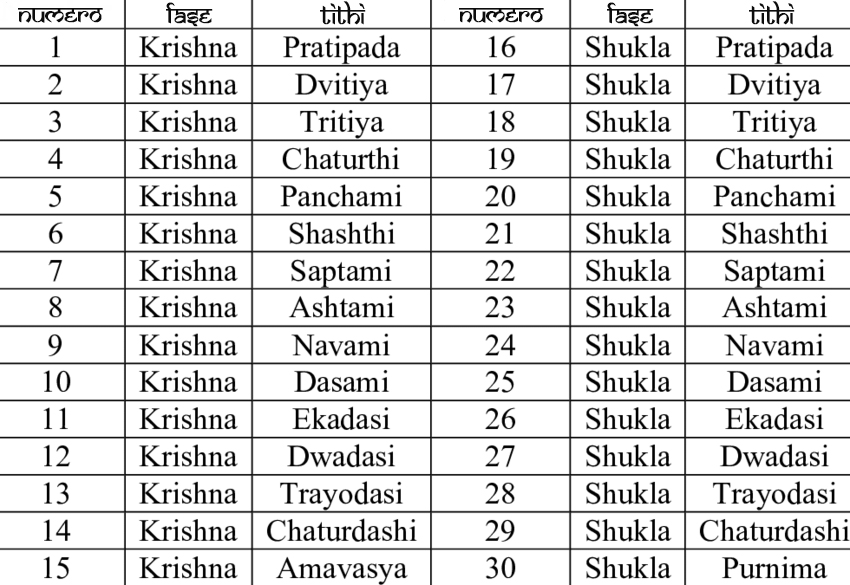
To worship with the mantra, the names of the different Nityas are preceded by:
Aim Hrim Shrimbija
and then with the suffix:
Shri Padukam Pujayami Tarpayami Namah
For example:
Aim Hrim Shrimbija Kulasundari Shri Padukam Pujayami Tarpayami Namah
4.- Yantras and their meaning
Los yantras que se utilizan a continuación son los del Tantraraja, mientras que las sílabas sánscritas son las letras vocales asociadas con cada Nitya y día de la Luna.
The yantras used below are those of the Tantraraja, while the Sanskrit syllables are the vowel letters associated with each Nitya and day of the Moon.
5.- Discover the 15 Nitya Yantras
5.1- Kameshvari Nitya
The first of the Nityas in the crescent moon of the cycle is Kameshvari, a name meaning Lady of Desire. Her vidya (mantra) according to the Tantrarajatantra is:
Aim Hrim Shrim Am Aim Sa Ka La Hrim Nityaklinne Madadrave Sauh Am Kameshvari Nitya Shri Padukam Pujayami Tarpayami Namah
The Tantraraja gives his meditation image or dhyana, a red color like 10 million suns of dawn, with ruby diadem, necklaces, belts and rings. She is red, has six arms and three eyes, wears a crescent moon, and smiles gently. She holds a sugarcane bow, blossom arrows, a lasso, a goad, and a cup filled with nectar. She shows the mudra of bestowing boons.
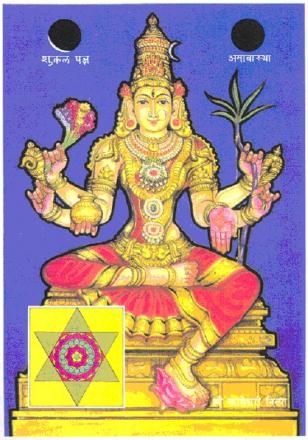
The five arrows of desire (Kama) in the five petals are: Longing, Madness, Passion, Enchantment and Attrition. These five desires are the five forms of Kamadeva, which are Kamaraja (Hrim), Manmatha (Klim), Kandarpa (Aim), Makara (Blum) and Manobhava (Strim). Its colors are yellow, white, red, violet and blue (the shape of the five elements).
5.2- Bhagamalini Nitya
The name of the next of the Nityas in the crescent moon, Bhagamalini, refers to the blossoming yoni, and is the second Nitya of the cycle of the crescent Moon. It has a remarkable and very long mantra (vidya) that says:
Aim Hrim Shrim Am Aim Bhagabuge Bhagini Bhagodari Bhagamale Bhagavahe Bhagagavasguhye Bhagayoni Bhabhagaipagarhani Sarvai Nityaklinne
Bhagasvarupe Sarvani Bhagani Me Hyanaya Varade Rete Surete Bhagaklinne Klinnadrave Kledaya Dravaya Amoghe Bhagavicce Kshubha Kshobhaya Sarvasatvan Bhagodari Aim Blum Jem Blum Bhem Blum Mom Blum Hem Blum Hem Bhama Bhamalini.
Tantrarajatantra describes her as having six arms, three eyes, sitting on a lotus, and holding a nocturnal water lily, a noose and a sugarcane bow in her left hand, and in her right, a lotus, goad and blossoming arrows. Around her there are a multitude of Shaktis, all of whom resemble to her.
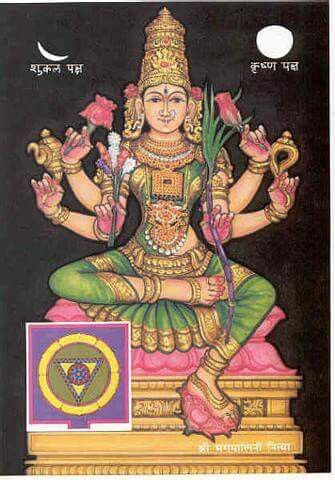
In the Dakshinamurti Samhita the Bhagamalini Nitya has a different image (dhyana). She is described as living in the middle of a flowery forest, adorned with various gems, holding a rope, a goad, a book, and a scale. She shows her mudras or hand gestures to alleviate fears and bestow boons.
5.3- Nityaklinna Nitya
Her name means the wet Nitya, and she is the third Nitya of the crescent moon.
Nitya Nityaklinna‘s mantra is:
Aim Hrim Shrim Nityaklinne Madadrave Svaha im Nityaklinna Nitya Shri Padukam Pujayami Tarpayami Namah.
According to Tantraraja she is surrounded by 19 Shaktis, which are Kshobhini, Mohini, Lila, Nitya, Niranjana, Klinna, Kledini, Madanatura, Madadrava, Dravini, Vidhana, Madavila, Mangala, Manmatharta, Manashvini, Moha, Amoda, Manomayi, Maya, Manda and Manovati. Nityaklinna herself, says the same tantra, is restless with desire, spreaded with red sandalwood paste, wears red clothes, smiles, has a crescent on her head, and holds a rope, a goad, a cup, and does the mudra that dissipates fear.

In the Dakshinamurti Samhita (chapter 42) she gives an 11-syllable root mantra:
Hrim Nityaklinna Madadrave Svaha.
The image is similar, except that he holds a rope, a goad, a skull, and dispels fears. Her face is drenched in sweat and her eyes are moving with desire. Here, the yantra is described as trikona, eight petals, and earth square (bhupura).
Nityaklinna Nitya bestows enjoyment and liberation and subjects the three worlds for a siddha (successful) in his vidya (mantra).
5.4- Bherunda Nitya
Bherunda, the fourth Nitya in the crescent moon, has three eyes and eight arms. Her body is the color of molten gold, sporting beautiful ornaments on her hands, feet, arms, and around her waist. She smiles sweetly with her hands holding a lasso, goad, shield, sword, mace, thunderbolt (vajra), bow and arrows.
According to Tantraraja, using his mantra destroys the poison. His vidya mantra is:
Aim Hrim Shrim Im Om Krom Bhrom Kraum Jhmraum Cchraum Jraum Svaha Im Bherunda Nitya Shri Padukam Pujayami Tarpayami Namah

The Dakshinamurti Samhita describes its yantra as a triangle, eight petals, and bhupura. Shikhini, Nilakanthi and Raudri are in the triangle. Bherunda, according to this source, rules over the Vetalas or evil spirits.
5.5- Vahnivasini Nitya
Vahnivasini is the fifth Nitya (Eternity) in the cycle, his name means the dweller of fire. Her mantra is:
Om Hrim Vahnivasiniyai Namah
The Shaktis of his eight trikonas are Jvalini, Visphulingini, Mangala, Sumanohara, Kanaka, Ankita, Vishva and Vividha. On the 12 petals are the 12 signs of the Hindu zodiac.
Her description in the Tantraraja is that of a beautiful young girl, color of gold, with eight arms, dressed in yellow silk garments, adorned with rubies.
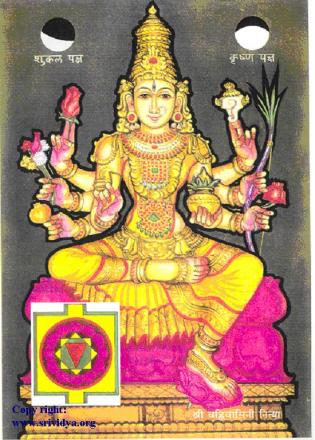
She holds a red lotus, a conch shell, a red sugar cane ribbon, and the full moon in her left hand; to her right, a white water lily, a golden horn, flowery arrows and a citron. Around her are innumerable Shaktis that resemble her. She is the dweller of the fire that devours the universe.
5.6- Mahavajreshvari Nitya
“Maha” means great, or the greatest. “Vajra” means strong like a diamond (or a thunderbolt). “Ishwari” means mighty. His name, then, translates as the great mighty thunderbolt. Mahavajreshvari grants reaching the goals that have been proposed. This sixth night is the first of the second group of kalas, which represent the achievement of what has been desired. Being the first tithi of this group, she is strong with the energy of quick action and achievement, that moment when one finally achieves what is desired. That specific energy that accompanies the moment of achievement.
Her vidya-mantra is:
Um Hrim Klinne Aim Krom Nityamadadrave
Hrim Um Mahavajreshvari Nitya Shri Padukam
Pujayami Tarpayami Namah.
In the Tantraraja she is described as having four arms, three eyes, dressed in red, red colored, with red jewels and strewn with red flowers, wearing a ruby crown. She sits on a throne in a golden boat floating on a blood ocean, and she holds a rope, a goad, a sugarcane bow, and flowered arrows.
She is surrounded by a large number of Shaktis similar to her and sways while smiling mercifully.

In the Dakshinamurti Samhita she is different, she is described as wearing red clothes and holding a rope, a goad, a skull and dispelling fear.She staggers from having drunk pure wine. The yantra here is described as a triangle, four petals, eight petals, and a bhupura.
5.7- Sivaduti Nitya
She is called Shivaduti because she acts as Shiva’s messenger (Duti).
Her mantra is:
“Aim Hrim Shrim Shivadutyai Namah Shivadutinitya Shri Padukam Pujayami Tarpayami Namah”.
According to Nityotsava, an expansion of the Kalpasutras, Shivaduti Nitya’s vidya-mantra is:
Aim Hrim Shrim Shivadutyai Namah Shivadutinitya Shri
Padukam Pujayami Tarpayami Namah
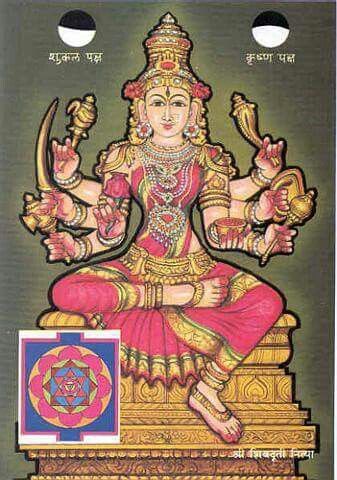
In the Tantraraja she is described as dressed in red, with nine jewels on her crown, surrounded by Rishis who sing her praises, and as having eight arms and three eyes. She looks as bright as the midday summer sun and she smiles sweetly. Her hands hold a horn, shield, mace, cup, goad, axe, axe, and a lotus flower.
5.8- Tvarita Nitya
Tvarita, in the Nityas on the crescent moon, refers to the cycle of Eternity. She is also called Totala Devi. She is called Tvarita, as she quickly bestows fruit to sadhaka. She is an auspicious shape: she represents the awakening of youth.
She has 3 eyes and 4 hands and her beautiful lotus face smiles gently. She is clothed in new leaves. She is adorned with 8 big ferocious snakes of 4 kinds, and with chains and anklets. On her head there is a crystal crown with a crest of peacock feathers. Her arms are adorned with bracelets made of beautiful peacock feathers. She has an umbrella and a banner made of peacock feathers. She wears strings of gunja (red) berries around her neck, and her breasts are smeared with red sandal and kumkum. She holds a rope, a goad, dispels fear and bestows boons.
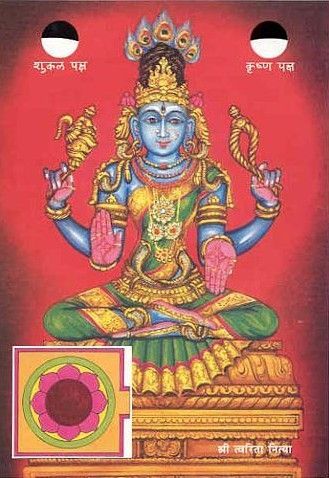
Her mantra is:
Om Hrim Hum Khe Ca Che Ksah Strim Hum Kse Hrim Phat.
Tvarita Puja
Fully relaxed, facing East, and having done three pranayamas, place the yantra in front of you, visualizing Devi Tvarita in your heart. Place a flower in the center of the yantra as an offering.
The triple line of the Guru is worshiped first, as if it were in the three circles, then the servant of the Devi who is in the west of the Yantra. Worship Jaya and Vijaya on both sides of the door. Worship Tvarita Devi in the center.
5.9- Kulasundari Nitya
Sri Kulasundari is auspicious, most kind and blissful with twelve arms and six lotus faces and with three eyes on each face, smiling sweetly.
She grants knowledge to her Sadhaka and makes him Sarvajna (omniscient). To obtain knowledge, wealth and the annihilation of your enemies, she must be meditated on. Respectively, with the colors white, gold and dark blue.
His vidya-mantra is:
Aim Hrim Shrim Aim Klim Sauh Kulasundari Nitya Shri Padukam Pujayami Tarpayami Namah
She has twelve arms and six faces, according to the Tantraraja. In her right hand she holds a mala or coral rosary, a lotus flower, a gem-studded jar, and shows a mudra. Her left hand holds a book, the red lotus, the golden feather, the gem garland, the seashell, and the last blessing mudra. Around her, there are hosts of Kinnaras, Yakshas, Devas and Gandharvas.

The letters of the vidya Aim Klim Sauh comprise the Tripura bulb which is the united state of knower, knowledge and object of knowledge; the three humors of Vata, Kapha and Sleshma; and Fire, Sun and Moon.
According to the DS (chapter 48), Kulasundari is identical to Bala and is placed in the eastern lion seat.
5.10- Sri Nitya
Sri Nitya controls all moving bodies and by her, and resides in all Jivas. She is the Chaitanya that dwells in all of us. She is the presiding deity Dakini and the six Chakras of the body.
Colored like the rising sun, her face is illuminated by a soft smile, and she wears a luminous crown on her head. She is dressed in red clothes and adorned with red rubies. She has three eyes and twelve hands. With her right hand she carries the rope, the white lotus, the sugar cane bow, the shield, the trident and the Vara Mudra. She carries a goad, book, flowery arrows, sword, skull and Abhaya Mudra in her left hand. Her Shaktis are innumerable and form a complete circle around her.
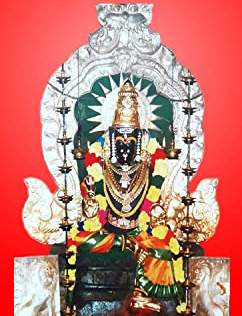
She grants Vaksiddhi to her Sadhaka by which he can give blessings or curses to others. Furthermore, she also bestows supreme physical strength.
The Kalpasutra version of the Nitya Nitya mantra is:
Ha Sa Ka La Ra Daim Ha Sa Ka La Ra Dim Ha Sa Ka La Ra Dauh Nitya Nitya Shri Padukam Pujayami Tarpayami Namah
5.11- Nilapataka Nitya
Her name means Sapphire Banner and her mantra is:
Aim Hrim Shrim Phrem Strum Krom Am Klim Aim Blum Nityamadadrave Hum Phrem Hrim Em Nilapataka Nitya Shri Padukam
Pujayami Tarpayami Namah.
The Tantraraja says that she is sapphire-colored, with five faces and ten arms, dressed in red clothes and beautiful gems. Her left hands show the rope, banner, shield, horn bow, and gift-bestowing mudra. Her right hands show a goad, a dart, a sword, arrows, and the mudra that banishes fear.

She rules over the Yakshinis and the 64 Chetakas, and has an amazing collection of siddhis or magical powers to bestow on her sadhaka or sadhika. These gifts include a sword invincible in battle (Khadga siddhi), the power to see through walls (Anjana), the ability to travel miles in an instant (Paduka Siddhi), and others.
5.12- Vijaya Nitya
Vijaya Nitya brings victory in battle and success in buying and selling, hence her name, Victorious.
Her vidya mantra is:
Aim Hrim Shrim Bha Ma Ra Ya Aum Aim Vijaya Nitya Shri Padukam Pujayami Tarpayami Namah.
According to the Dakshinamurti Samhita she has a head and 10 arms, and wears a garland of human skulls.
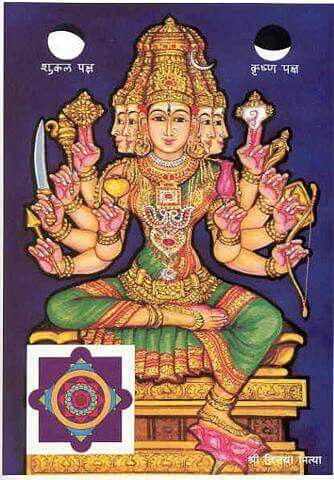
The image of dhyana or meditation in Tantraraja differs from this. There she has five heads and 10 arms, which hold a snail, a lasso, a shield, a bow, a white lily, a disk, a stinger, arrows and a lemon.
5.13- Sarvamangala Nitya
Her name means “auspicious” as she grants progress, both in the material and spiritual worlds. She protects her devotees during the journey (of life) and her vidya mantra is:
Aim Hrim Shrim Svaum Om Sarvamangala Nitya Shri Padukam Pujayami Tarpayami Namah.
She has two arms and a head, she sits on her lotus yantra and has eyes that represent the sun and the moon, while she smiles sweetly.

In her right hand she holds a citron and with her left she shows the mudra that gives blessings. All her 76 attendants surround her, they are solar, lunar and fiery. She rules over the kalas of the sun (12), the moon (16) and fire (10). This number 38 and her assistants are duplicated because each one is with her consort.
5.14- Jvalamalini Nitya
Her name means “garlands of flames”, SriJ walamalini Devi is bright as fire, resplendent in her ruby crown.
His mantra, according to Tantrarajatantra is:
Om namo bhagavati Jvalamalini devadevi sarvabhutasamharakarike jatavedasi jvalanti jvala jvala prajvala prajvala Hrim Hrim Hum Ram Ram Ram Ram Ram Ram Ram Jvalamalini Hum Phat Svaha.
Within the Nityas in the crescent moon, she represents the flames, she is surrounded by Shaktis, each of whom resembles her and she herself has a body of flaming fire, with six faces and 12 arms. Each one of her faces, each with three eyes, smiles sweetly

His 12 hands hold the rope, the goad, the arrow, the mace, the tortoise, the spear, the flame and he shows two mudras: bestowing blessings and dispelling fear.
The Dakshinamurti Samhita gives it a different yantra. One of the mandalas has 40 instead of 32 petals.
The Shaktis and their description also show variants. She is described as sitting on a lion seat and she is holding different weapons including the damaru drum and a wine jug.
5.15- Chitra Nitya
The last in the cycle of Nityas in the crescent moon is Chitra, which means “marbled“, and wears a silk garment of different colors, has four arms, a head and holds a rope, a goad and shows the mudras bestowing boons and dispelling fears.
Her mantra is:
Aim Hrim Shrim Ckaum Am Chitra Nitya Shri Padukam Pujayami Tarpayami Namah
Sri Chitra es brillante como los rayos del sol naciente, adornada con joyas hechas de nueve tipos de gemas, que también están engastadas en su corona. Tiene cuatro brazos y tres ojos y está vestida con una maravillosa prenda de seda de color abigarrado. Una pura sonrisa ilumina su rostro. Sri Chitra es toda dichosa y siempre existe, concediendo todos los deseos. En sus cuatro brazos, sostiene la soga, el aguijón, vara y Abhaya Mudras.
Sri Chitra is bright like the rays of the rising sun, adorned with jewels made of nine kinds of gems, which are also set in her crown. She has four arms and three eyes and is dressed in a wonderful variegated silk garment. A pure smile lights up her face. Sri Chitra is all blissful and she always exists, granting all wishes. In her four arms, she holds the rope, goad, wand and Abhaya Mudras.

Chitra bestows wealth and self-knowledge (Atmalabha) on her Sadhaka. His Sadhaka is capable of subjugating others to the way of thinking gained from him. She showers her devotee with sudden riches like treasures, prizes, etc.
About our purpose:
“Our effort is focused on offering quality content based on the sacred scriptures of traditional Hatha Yoga. Also on the oral Tantra of the Shakta tradition of Kashmir Shivaism, the most relevant aspects of the Hindu spirituality and Advaita Vedānta.
In our Western society, ignorant and compliant, both Yoga and Tantra are continually vilified and missunderstood by multiple pseudo-masters, who contoct, for their own benefit, versions of this ancient traditions.
The time to offer close content has arrived, based on the sacred Hinduism scriptures, so that the truth of Traditional Yoga and Shivaita Tantra tradition begin to grow up in our society.
We prostate in front of Sri Nityananda and Sri Muktananda, links in our tantric tradition, who impel us to perform this work. But above all, thank the inspiration of our guru, Swami Satyananda Saraswati, who is a source of guidance, love and divine inspiration“

